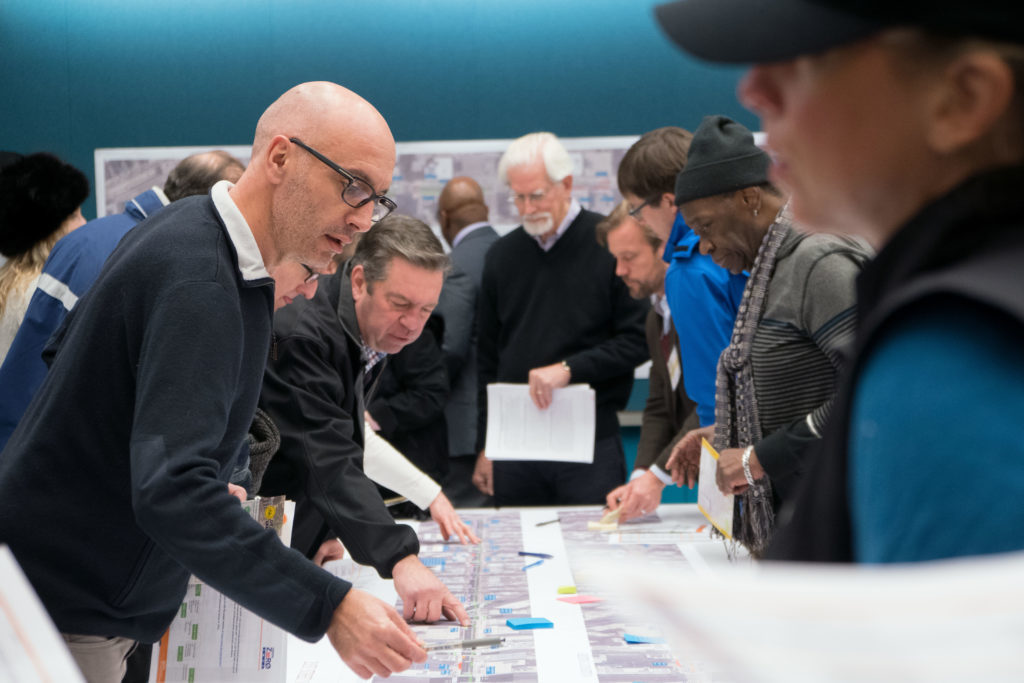The District Department of Transportation met with residents Wednesday night to solicit feedback on the addition of a new two-way bike lane that will run through the Foggy Bottom Campus.
About 40 residents gathered at the West End Public Library to advocate for better safety measures for bikers or to express concerns about how the lanes will be used. The bike lane – which will be built on either 20th, 21st or 22nd streets – will connect the National Mall and Dupont Circle and is set to be completed by 2022, officials said.
Community members and DDOT officials first began discussing the possibility of a new bike lane in 2016 after launching a study on transportation in Foggy Bottom. DDOT presented initial plans to revamp parts of Pennsylvania Avenue in 2017.
Transportation officials presented four potential plans for the bike lane at the meeting Wednesday outlining what the lane would look like and how the agency would implement safety measures, like barricades, for bikers.
The proposal for 22nd Street offers a two-way protected bike lane on the east side of the street that would run from Massachusetts Avenue to F Street, while the lane on 20th Street would run on the west side of the road from Constitution Avenue to E Street, officials said.
Authorities also presented two possible options for the lane on 21st Street. The first would construct a two-way protected lane on the east side of the street running from Florida Avenue to Constitution Avenue. The second would create an unprotected bike lane from Florida Avenue to New Hampshire Avenue and a two-way protected bike lane on the east side of the street from New Hampshire Avenue to Virginia Avenue.
[gwh_image id=”1074282″ credit=”Dean Whitelaw | Hatchet Photographer” align=”none” size=”embedded-img”]Officials from the D.C. Department of Transportation presented four possible plans for the new bike lane. [/gwh_image]
Megan Kanagy, a transportation planner for DDOT, said officials have discussed building protective measures for the new lane, like adding raised barriers that would protect bikers from vehicles and redesigning traffic signals and turning lanes to prevent biking accidents.
She said the proposals would also remove either a parking lane, a driving lane or both from each of the prospective streets to make room for the bicyclists. She said the trade-offs are essential for the project’s success because the lane will run through roads congested with cars.
“We’ve tried to also make sure that the intersections are safe, so that means when we have turns that are happening across the bike lane that they have a separate signal phase,” Kanagy said. “That protects pedestrians and cyclists who are crossing along that leg.”
James Harnett, a junior and member of the Foggy Bottom and West End Advisory Neighborhood Commission, said he would like to see the bike lane project accelerated to ensure cyclist safety as soon as possible.
“I want this to be something that students can experience and something they can reap the benefits of now,” he said.
Harnett said the project is an important facet to Vision Zero, a DDOT initiative that aims to eliminate all traffic-related fatalities and “serious” injuries by 2024 through a “more effective use of data, education, enforcement and engineering,” according to the DDOT website.
“I’m disappointed in the mayor’s progress towards completing Vision Zero by 2024,” Harnett said. “Hopefully this project, along with others DDOT is considering, will help address the concerns that I have about ensuring that we’re building protected, safe bicycle networks for people that want to navigate across the city.”
Community members at the open house said they support the project because it will create a safe way for cyclists to travel through the District.
Rudi Reit, a cyclist who has lived in Dupont Circle for 16 years, said the bike lane would benefit those who live in the area because many residents rely on biking, walking or public transportation to get around the city.
“As a person who rides a bike every day, it’s very important that we have safe means to get from point A to point B,” Reit said.
Michael Schade, a resident who lives near 15th and U streets near an existing protected bike lane, said he supports the proposal for a bike lane on 21st Street because it would increase the connectivity of bike lanes in the District.
“I love the 15th Street cycle track,” Schade said. “I would love to see it expanded to elsewhere in Dupont Circle and to have it form a network, so 15th Street, to R Street, to Q Street.”
Some residents at the meeting expressed concerns that the new bike lanes will not change how bikers navigate through the District because current bike lanes are not used properly.
Kerry Bedard, a resident who lives on H and 21st streets, said implementing one of the three proposals would not reduce the number of bikers on sidewalks because bikers in the District do not use lanes that already exist.
“There are cyclists on the sidewalk every day, because they’re not required, or they don’t think they’re required, to use the bike lanes,” Bedard said. “They don’t know what the regulations are, nobody knows what the regulations are, and the bicycles should be licensed just like the cars are licensed.”





